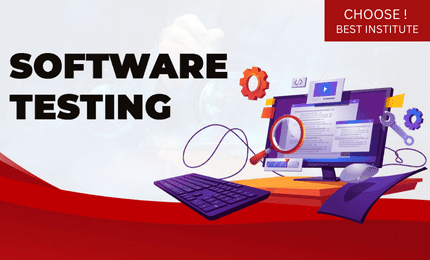Welcome, tech enthusiasts, developers and inquisitive minds!
Imagine a world in which every single click, swipe and tap is driven by next-gen software, and reliability and performance are at the top of the agenda.
Today, I’m going to take you on an exciting journey into the core of tomorrow’s software testing. A world where innovation reigns supreme and agility is at the forefront.
Whether you’re deep in code or you’re just dipping your toe in the deep tech pond, you’ve come to the right place.
Buckle up – because you’re about to embark on one of the most exciting journeys of your life.
In this blog, we’ll explore everything from the secrets of AI to the symphonies of DevOps and the driving force behind quality assurance.
The future is here, and it’s time to discover nuances that will redefine how we deliver software excellence.
Welcome to the future!
1) Introduction
What is the current status of software testing?
As we approach the 2024 milestone, it’s important to take a step back and reflect on what’s happening in the software testing world. The landscape of software testing is constantly changing due to technological advances and changing industry needs. Traditional testing methods are being replaced by cutting-edge approaches, where automation, collaboration and agility are at the forefront.
The Changing Landscape of Technology and Its Impact
Testing Advances in technology, such as AI and cloud computing, are changing the way we create and test software. This not only opens up new opportunities, but also presents challenges that require a complete re-think of testing strategies.
The Importance of Staying Ahead Staying ahead
In the dynamic world of software testing is not only an advantage; it’s a must. Testers need to stay up-to-date with the latest trends, technologies and methodologies to make sure their testing processes are effective. In this blog, we’ll explore how testers can stay ahead of the game and thrive in the changing landscape of software testing.
2) Automation Revolution
The rise of AI and machine learning in software testing
Automation is at the core of today’s software testing, and it’s changing the way testers do their jobs. Automation automates tedious, time-consuming, and repetitive testing processes, allowing testers to concentrate on more important and strategic tasks.
This shift has led to dramatic improvements in testing productivity, quality of work, scalability, and consistency.
Web application testing frameworks like Selenium or Cypress provide a solid foundation for automation. These frameworks allow testers to build and run automated test scripts that mimic user interactions and verify application behavior.
Continuous integration and continuous delivery pipelines help automate testing by bringing testing into the continuous development lifecycle. CI and CD pipelines test and validate new code before it is deployed.
Robotic process automation (RPA)
Another new area of software testing automation is Robotic Process Automation (RPA). With RPA tools, testers can automate tasks that require interaction with desktops or legacy systems. This broadens the scope of the automation to include web applications as well.
There are many advantages to automation, but it also comes with its own set of challenges. Setting up and maintaining an automated testing suite can be time-consuming and requires careful planning and regular maintenance. It’s up to the tester to ensure that the automated tests are well-designed, cover critical scenarios, and adjust to changes within the application.
The Integration of Artificial Intelligence (AI): Revolutionizing Test Generation, Defect Detection, and Optimization
AI is set to revolutionize software testing by bringing new levels of intelligence and flexibility. Testing tools powered by AI can automate tasks that were once too complex or laborious for traditional automation techniques.
AI is revolutionizing test generation. By analyzing application code and users’ behavior patterns, AI algorithms can generate test cases for a wide variety of scenarios, such as edge cases, rare conditions, and more. This drastically reduces the amount of time needed to create complex test suites.
AI is transforming defect detection. By analyzing test results and app logs, AI can provide testers with valuable insight into application behavior, which can drastically reduce the time needed to identify and correct bugs.
Testing optimization is another AI-driven area of innovation. By analyzing test suites and determining if they are redundant or inefficient, AI algorithms can suggest optimizations that can increase overall testing efficiency and reduce testing execution times and resource consumption.
The Shift Towards Continuous Testing: Enabling Agile Software Development
Continuous testing is an essential component of agile software development methodology, where rapid iteration and frequent release cycles are the standard. Continuous testing ensures that software is being tested throughout the entire development life cycle, giving early feedback on bugs and making sure new features are incorporated smoothly. Continuous testing involves integrating testing activities into your development pipeline, so that testers can get feedback on your code as you write. This approach encourages early defect detection and allows you to fix bugs quickly and reduce the impact of bugs on your project timeline. Continuous testing also automates testing tasks and integrates them into your CI /CD pipeline. Automating testing ensures that every change in your code triggers a complete set of tests to validate the quality and behavior of your application.
To implement continuous testing practices, there must be a cultural change within your software development team. Testers must work closely with you. They must integrate testing into your development workflow and provide you with feedback as soon as possible. Developers must also become test-driven, writing code that is testable and accepting testing as a part of their development process.
Impact on traditional testing roles
The role of traditional testers is changing as automation takes the spotlight. Testers need to adapt. AI and automation are no longer adversaries, but rather allies. This is an exciting time for testers to take on the role of “organizers” of automated testing processes and make sure they are relevant and effective in a testing environment that is constantly evolving.
3) Shift-Left and DevOps Integration
1.Accelerating testing processes with a Shift-Left approach
The “Shift-Left” approach encourages testing to be part of the development lifecycle as early as possible. Integrating testing from the start of a project allows for defects to be identified and fixed earlier, saving costs and time later in the development cycle. In this section, we look at how a shift-left mindset can speed up testing processes and enhance software quality.
2.Seamless integration of testing into DevOps practices
The DevOps is the process of working together between development and operations to deliver software. This article looks at how testing can be integrated into DevOps practices and how automation can be included in CI/CD pipelines. The goal is to deliver faster, more robust releases that meet the needs of today’s software development.
4) Quality Assurance in the Cloud
Software testing is changing with the times. Open-source testing tools, performance testing, and cloud-based solutions are some of the emerging trends that will shape the future of software testing. These tools offer cost-effective, customizable solutions that allow testers to build their own testing infrastructure without having to rely on proprietary solutions. Performance testing is also becoming more important as applications get more complex and handle more data. Performance testing allows testers to evaluate the responsiveness of an application, its scalability, and its load-handling ability in real-world scenarios.
1.Cloud-based testing environments and services
Testing in the cloud is more than just a storage solution. It’s a dynamic testing environment with scalability, flexibility and accessibility. In this section, we’ll explore the cost-effectiveness, replicable real-world scenarios and challenges associated with data security in a cloud-based testing environment.
2.Leveraging cloud-native technologies for testing
As cloud-native technologies become more popular, testers have access to new tools. Serverless testing and containerization are two examples of how cloud-native technologies can improve testing capabilities and provide a basis for scalable, agile testing processes.
5) Enhanced Security Testing
Security in Software Testing
The importance of security testing in software development has never been more important as cyber threats become more advanced.
In this section, we look at the changing landscape of security testing and why it’s important to take a proactive approach to identify and address vulnerabilities early in the software development lifecycle.
New methodologies and tools for security testing
In this section, we’ll take a look at new security testing methods and tools. Security testing is a critical part of any successful security testing strategy, and automated penetration testing (APT) and compliance-oriented testing (CDT) are two of the most important components of a successful security testing program.
Let’s take a look at how these new methods and tools can help you build secure software apps that meet regulatory requirements.
6) Cognitive Testing and User Experience
Understanding the User’s Point of View
Testing isn’t just about finding bugs, it’s about creating a great user experience. In this section, we’ll look at how to integrate cognitive testing, which looks at how users behave and what their expectations are. By including cognitive testing in testing, software professionals can make sure their applications meet the needs and preferences of different users.
Real-World Scenario Testing for Diverse User Interactions
The user experience is dynamic and different from one situation to another. This section looks at how to test for diverse user interactions in real-world scenarios. For example, testing for accessibility for users with different needs is important. By simulating different user interactions, testers will be able to identify potential issues and develop software that truly meets the needs of a wide variety of users.
7) Data-Driven Testing and Analytics
Utilizing Data for Testing Insights
Data is a powerful tool for testing, as it provides insights into the behavior and performance of the system. In this section, we’ll explore what data-driven testing is and its advantages, such as predictive analytics that helps identify problems before they affect users.
Including Big Data and Analytics in Test Schemes
When testing in data-driven applications, it’s important to take a strategic approach. We’ll look at how you can include big data and analytics in test scenarios, so you can make sure your testing processes match the complexity of today’s data-driven applications.
8) The Human Element in Testing
The Human Element in the Age of Automation
The human element in testing has never been more important than it is today. Human testers bring a unique set of skills to the table, such as critical thinking, exploratory testing, and the ability to adapt to changing environments. Human testers need to be able to work seamlessly with automated processes in order to deliver software of the highest quality.
Balancing the Human and Automated Element
The best testing teams balance human expertise with automated efficiency. Collaborative testing approaches that combine the strengths of humans and machines are the key to successful testing teams. Establishing a robust testing team culture requires communication, flexibility, and a common focus on software quality.
9) Conclusion
1) Key Trends Shaping the Future of Software Testing
To sum up, here are the key trends that will shape the future of testing:
Automation Testing
DevOps integration
Cloud-based testing
Enhanced security measures
Encouraging Testers to Learn and Adapt
Software testing is not a static field. Testers need to be constantly learning and adapting to new technologies, methods, and challenges. Investing in skills and staying informed will position testers as valuable contributors to software development.
What’s Next
Looking ahead, the future of testing promises to be exciting and challenging. The combination of human intelligence and technological advances creates a world where testers play a critical role in delivering software of the highest quality and user experience.
































